Abstract
Metabolism of retinoic acid to a less active metabolite, 4-hydroxyretinoic acid, occurs via cytochrome P-450 isozyme(s). Effect of a pharmacological dose of retinoic acid on the level of retinoic acid in skin and on cytochrome P-450 activity was investigated. A cream containing 0.1% retinoic acid or cream alone was applied topically to adult human skin for four days under occlusion. Treated areas were removed by a keratome and a microsomal fraction was isolated from each biopsy. In vitro incubation of 3H-retinoic acid with microsomes from in vivo retinoic acid treated sites resulted in a 4.5-fold increase (P = 0.0001, n = 13) in its transformation to 4-hydroxyretinoic acid in comparison to in vitro incubations with microsomes from in vivo cream alone treated sites. This cytochrome P-450 mediated activity was oxygen- and NADPH-dependent and was inhibited 68% by 5 microM ketoconazole (P = 0.0035, n = 8) and 51% by carbon monoxide (P = 0.02, n = 6). Cotransfection of individual retinoic acid receptors (RARs) or retinoid X receptor-alpha (RXR-alpha) and a chloramphenicol acetyl transferase (CAT) reporter plasmid containing a retinoic acid responsive element into CV-1 cells was used to determine the ED50 values for stimulation of CAT activity by retinoic acid and its metabolites. Levels of all trans and 13-cis RA in RA-treated tissues were greater than the ED50 values determined for all three RARs with these compounds. Furthermore, the level of all trans RA was greater than the ED50 for RXR-alpha whereas the 4-OH RA level was greater than the ED50 for RAR-beta and RAR-gamma but less than for RAR-alpha and RXR-alpha. These data suggest that there are sufficient amounts of retinoic acid in treated skin to activate gene transcription over both RARs and RXR-alpha.
Full text
PDF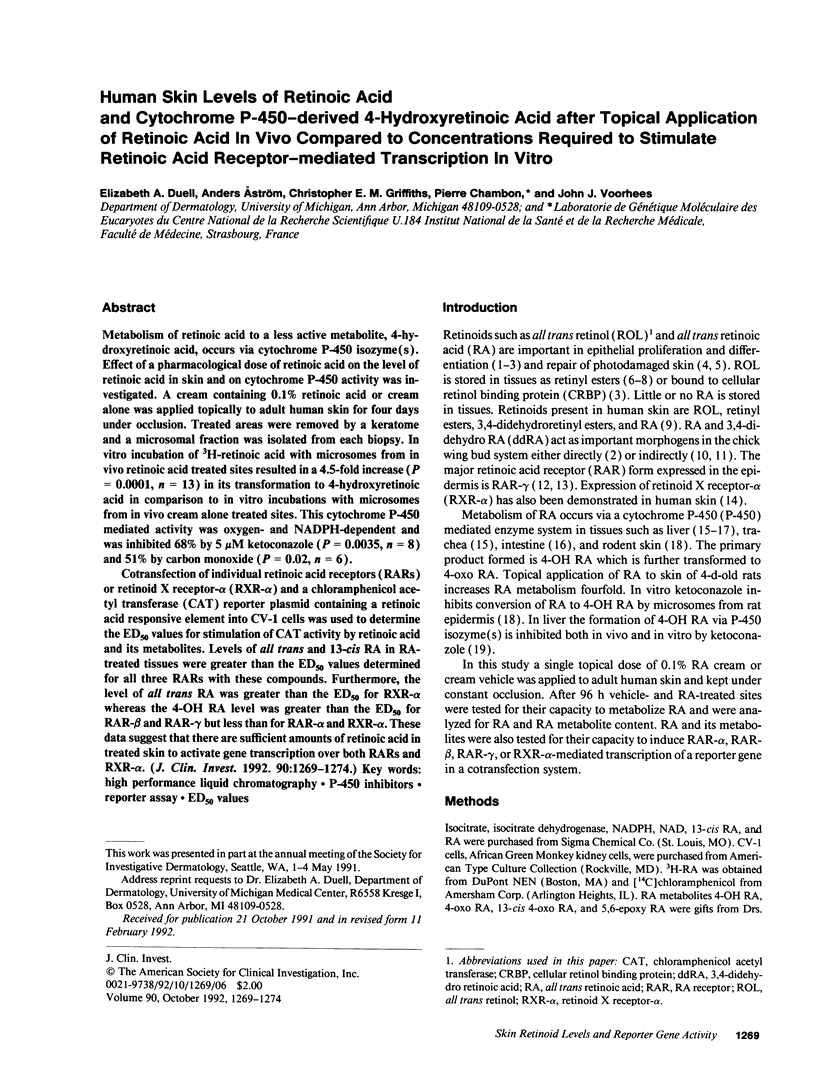
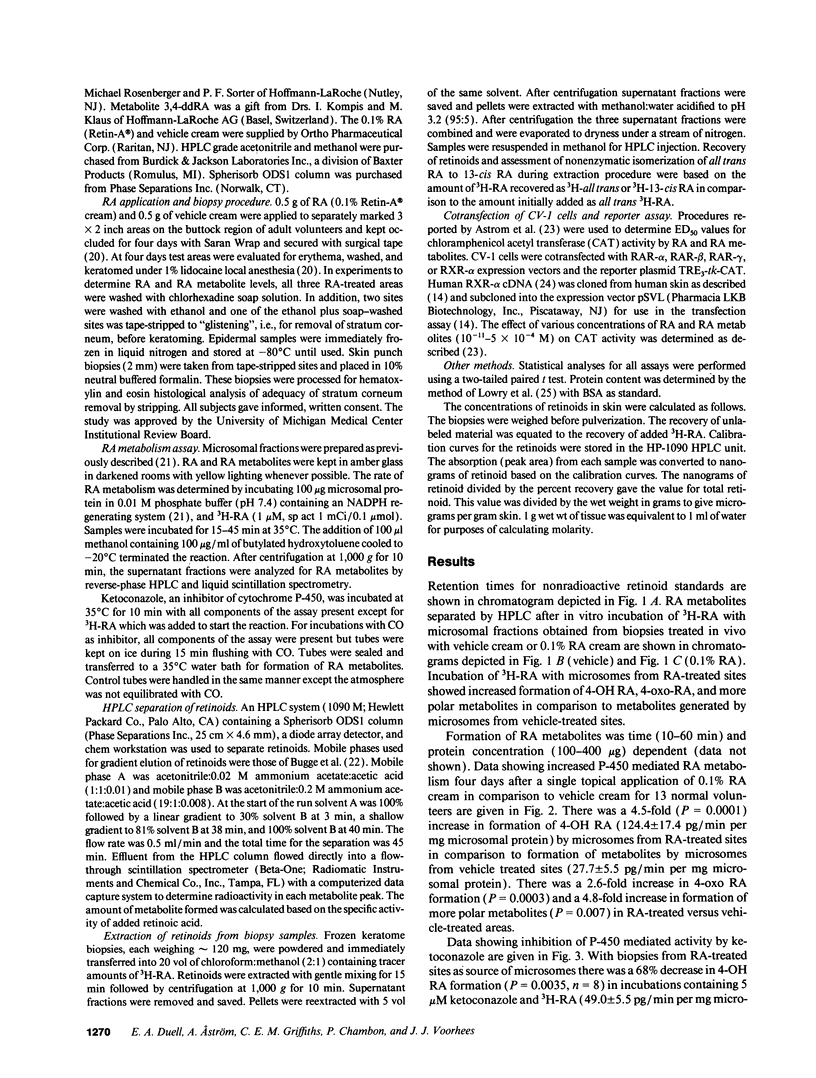
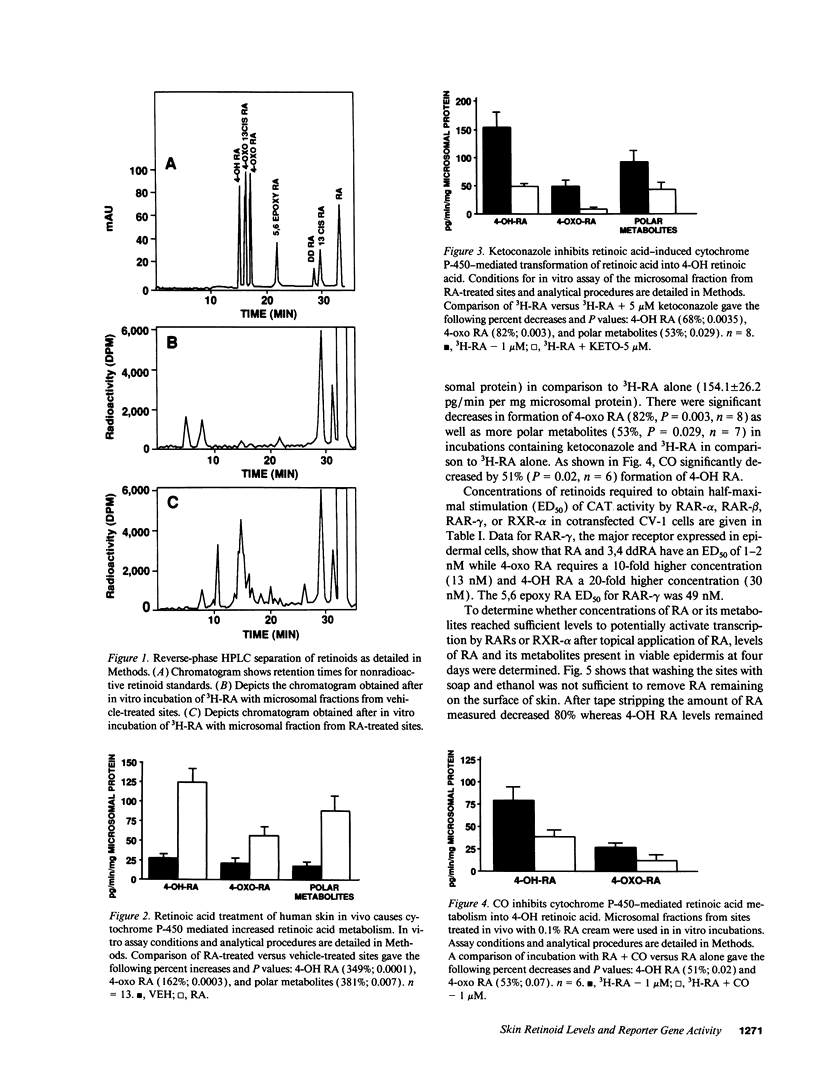
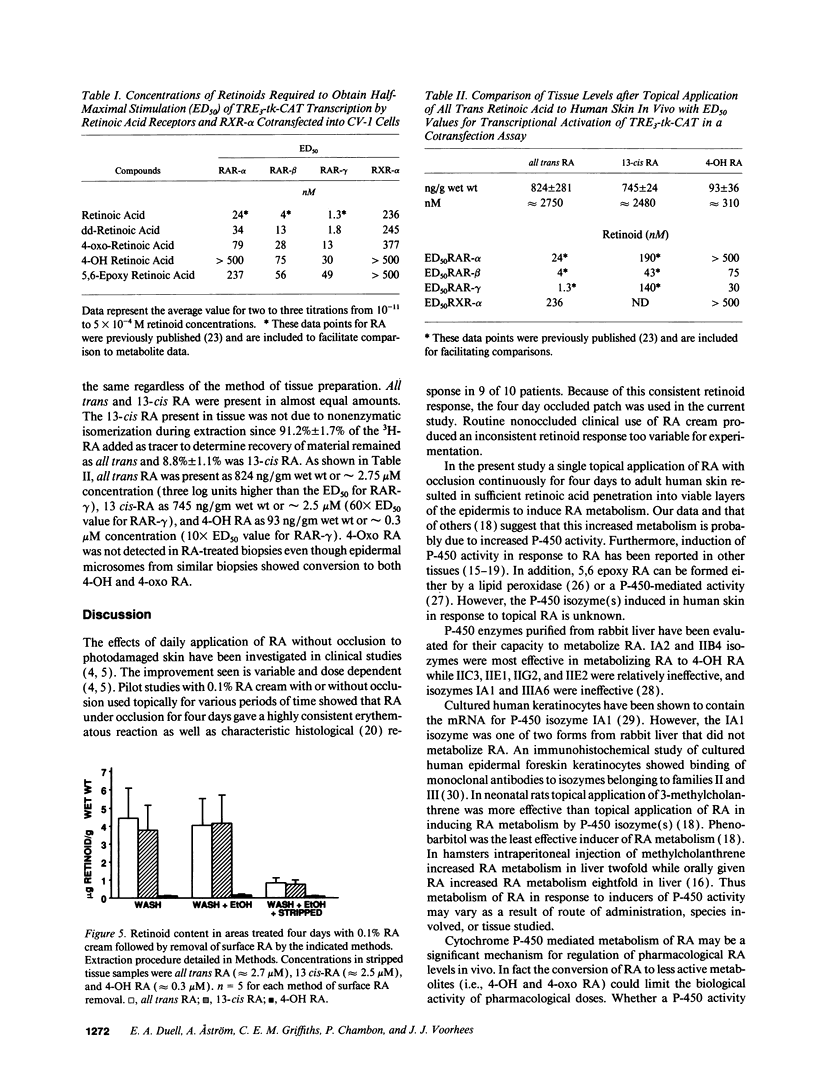
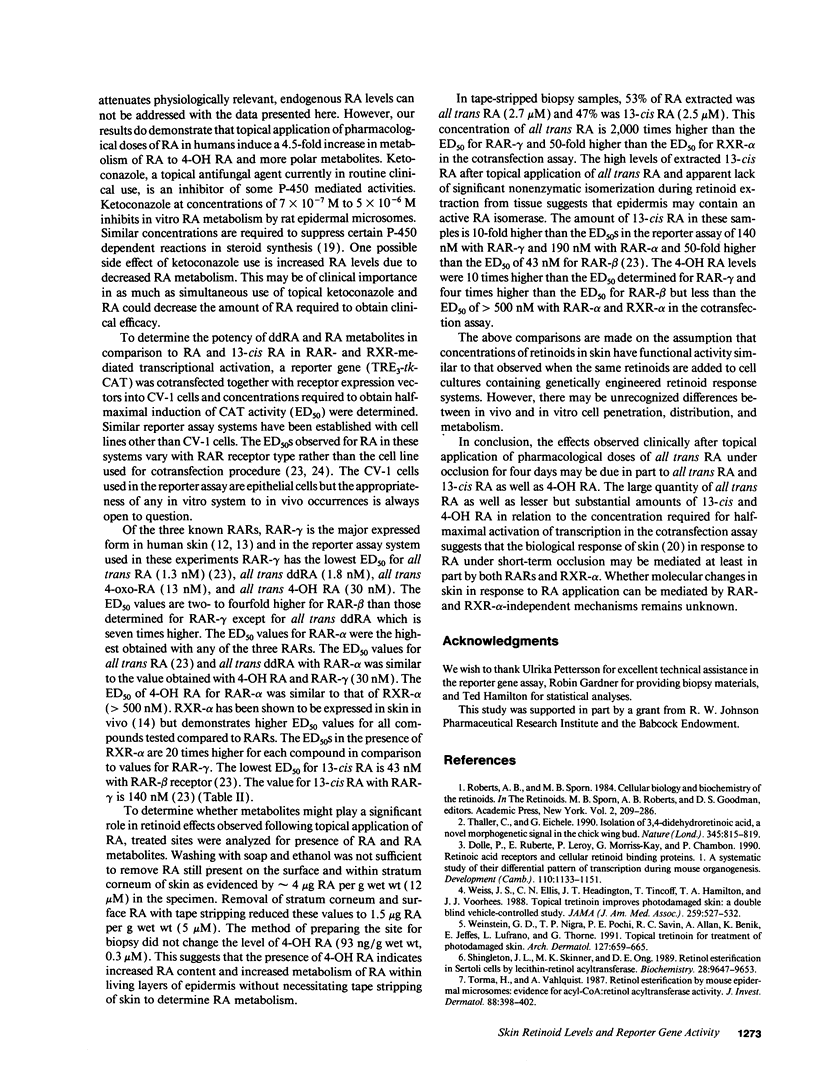
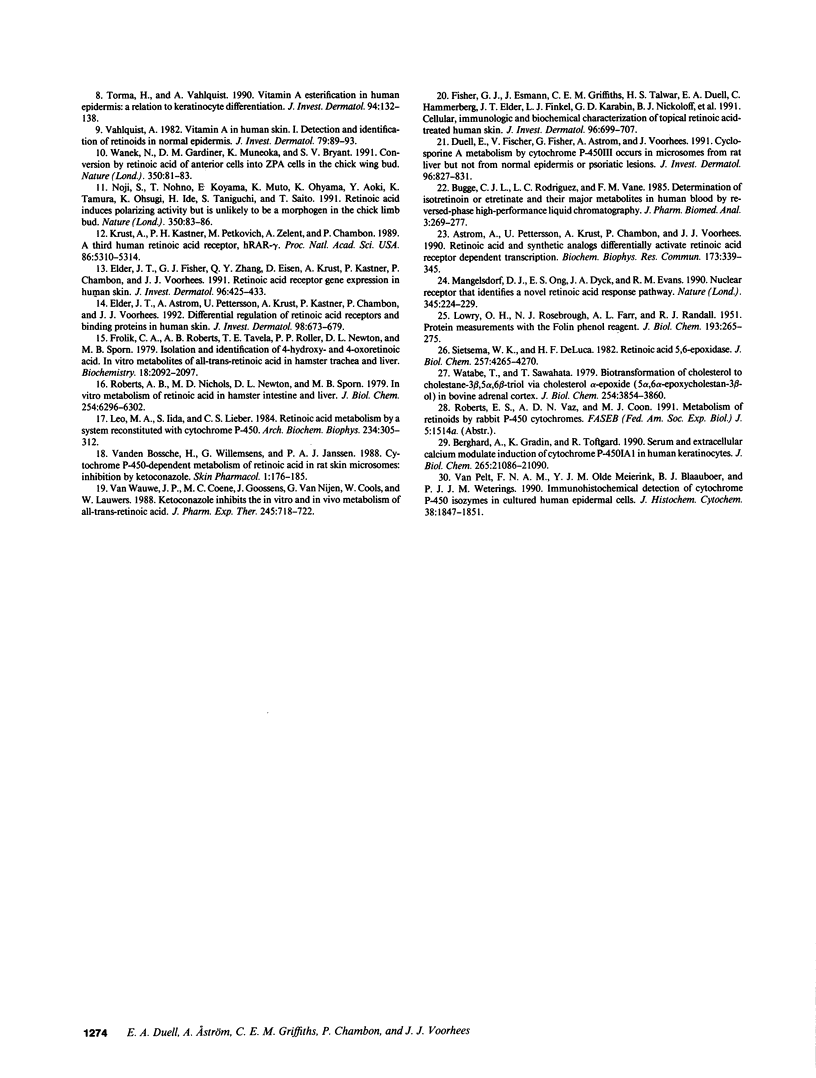
Selected References
These references are in PubMed. This may not be the complete list of references from this article.
- Aström A., Pettersson U., Krust A., Chambon P., Voorhees J. J. Retinoic acid and synthetic analogs differentially activate retinoic acid receptor dependent transcription. Biochem Biophys Res Commun. 1990 Nov 30;173(1):339–345. doi: 10.1016/s0006-291x(05)81062-9. [DOI] [PubMed] [Google Scholar]
- Berghard A., Gradin K., Toftgård R. Serum and extracellular calcium modulate induction of cytochrome P-450IA1 in human keratinocytes. J Biol Chem. 1990 Dec 5;265(34):21086–21090. [PubMed] [Google Scholar]
- Buggé C. J., Rodriguez L. C., Vane F. M. Determination of isotretinoin or etretinate and their major metabolites in human blood by reversed-phase high-performance liquid chromatography. J Pharm Biomed Anal. 1985;3(3):269–277. doi: 10.1016/0731-7085(85)80032-7. [DOI] [PubMed] [Google Scholar]
- Dollé P., Ruberte E., Leroy P., Morriss-Kay G., Chambon P. Retinoic acid receptors and cellular retinoid binding proteins. I. A systematic study of their differential pattern of transcription during mouse organogenesis. Development. 1990 Dec;110(4):1133–1151. doi: 10.1242/dev.110.4.1133. [DOI] [PubMed] [Google Scholar]
- Duell E., Fischer V., Fisher G., Astrom A., Voorhees J. Cyclosporine A metabolism by cytochrome P-450III occurs in microsomes from rat liver but not from normal epidermis or psoriatic lesions. J Invest Dermatol. 1991 Jun;96(6):827–831. doi: 10.1111/1523-1747.ep12474524. [DOI] [PubMed] [Google Scholar]
- Elder J. T., Aström A., Pettersson U., Tavakkol A., Griffiths C. E., Krust A., Kastner P., Chambon P., Voorhees J. J. Differential regulation of retinoic acid receptors and binding proteins in human skin. J Invest Dermatol. 1992 May;98(5):673–679. doi: 10.1111/1523-1747.ep12499896. [DOI] [PubMed] [Google Scholar]
- Elder J. T., Fisher G. J., Zhang Q. Y., Eisen D., Krust A., Kastner P., Chambon P., Voorhees J. J. Retinoic acid receptor gene expression in human skin. J Invest Dermatol. 1991 Apr;96(4):425–433. doi: 10.1111/1523-1747.ep12469889. [DOI] [PubMed] [Google Scholar]
- Fisher G. J., Esmann J., Griffiths C. E., Talwar H. S., Duell E. A., Hammerberg C., Elder J. T., Finkel L. J., Karabin G. D., Nickoloff B. J. Cellular, immunologic and biochemical characterization of topical retinoic acid-treated human skin. J Invest Dermatol. 1991 May;96(5):699–707. doi: 10.1111/1523-1747.ep12470632. [DOI] [PubMed] [Google Scholar]
- Frolik C. A., Roberts A. B., Tavela T. E., Roller P. P., Newton D. L., Sporn M. B. Isolation and identification of 4-hydroxy- and 4-oxoretinoic acid. In vitro metabolites of all-trans-retinoic acid in hamster trachea and liver. Biochemistry. 1979 May 15;18(10):2092–2097. doi: 10.1021/bi00577a039. [DOI] [PubMed] [Google Scholar]
- Krust A., Kastner P., Petkovich M., Zelent A., Chambon P. A third human retinoic acid receptor, hRAR-gamma. Proc Natl Acad Sci U S A. 1989 Jul;86(14):5310–5314. doi: 10.1073/pnas.86.14.5310. [DOI] [PMC free article] [PubMed] [Google Scholar]
- LOWRY O. H., ROSEBROUGH N. J., FARR A. L., RANDALL R. J. Protein measurement with the Folin phenol reagent. J Biol Chem. 1951 Nov;193(1):265–275. [PubMed] [Google Scholar]
- Leo M. A., Iida S., Lieber C. S. Retinoic acid metabolism by a system reconstituted with cytochrome P-450. Arch Biochem Biophys. 1984 Oct;234(1):305–312. doi: 10.1016/0003-9861(84)90353-9. [DOI] [PubMed] [Google Scholar]
- Mangelsdorf D. J., Ong E. S., Dyck J. A., Evans R. M. Nuclear receptor that identifies a novel retinoic acid response pathway. Nature. 1990 May 17;345(6272):224–229. doi: 10.1038/345224a0. [DOI] [PubMed] [Google Scholar]
- Noji S., Nohno T., Koyama E., Muto K., Ohyama K., Aoki Y., Tamura K., Ohsugi K., Ide H., Taniguchi S. Retinoic acid induces polarizing activity but is unlikely to be a morphogen in the chick limb bud. Nature. 1991 Mar 7;350(6313):83–86. doi: 10.1038/350083a0. [DOI] [PubMed] [Google Scholar]
- Roberts A. B., Nichols M. D., Newton D. L., Sporn M. B. In vitro metabolism of retinoic acid in hamster intestine and liver. J Biol Chem. 1979 Jul 25;254(14):6296–6302. [PubMed] [Google Scholar]
- Shingleton J. L., Skinner M. K., Ong D. E. Retinol esterification in Sertoli cells by lecithin-retinol acyltransferase. Biochemistry. 1989 Dec 12;28(25):9647–9653. doi: 10.1021/bi00451a016. [DOI] [PubMed] [Google Scholar]
- Sietsema W. K., DeLuca H. F. Retinoic acid 5,6-epoxidase. Properties and biological significance. J Biol Chem. 1982 Apr 25;257(8):4265–4270. [PubMed] [Google Scholar]
- Thaller C., Eichele G. Isolation of 3,4-didehydroretinoic acid, a novel morphogenetic signal in the chick wing bud. Nature. 1990 Jun 28;345(6278):815–819. doi: 10.1038/345815a0. [DOI] [PubMed] [Google Scholar]
- Törmä H., Vahlquist A. Retinol esterification by mouse epidermal microsomes: evidence for acyl-CoA:retinol acyltransferase activity. J Invest Dermatol. 1987 Apr;88(4):398–402. doi: 10.1111/1523-1747.ep12469726. [DOI] [PubMed] [Google Scholar]
- Törmä H., Vahlquist A. Vitamin A esterification in human epidermis: a relation to keratinocyte differentiation. J Invest Dermatol. 1990 Jan;94(1):132–138. doi: 10.1111/1523-1747.ep12873990. [DOI] [PubMed] [Google Scholar]
- Vahlquist A. Vitamin A in human skin: I. detection and identification of retinoids in normal epidermis. J Invest Dermatol. 1982 Aug;79(2):89–93. doi: 10.1111/1523-1747.ep12500032. [DOI] [PubMed] [Google Scholar]
- Van Pelt F. N., Meierink Y. J., Blaauboer B. J., Weterings P. J. Immunohistochemical detection of cytochrome P450 isoenzymes in cultured human epidermal cells. J Histochem Cytochem. 1990 Dec;38(12):1847–1851. doi: 10.1177/38.12.2254648. [DOI] [PubMed] [Google Scholar]
- Van Wauwe J. P., Coene M. C., Goossens J., Van Nijen G., Cools W., Lauwers W. Ketoconazole inhibits the in vitro and in vivo metabolism of all-trans-retinoic acid. J Pharmacol Exp Ther. 1988 May;245(2):718–722. [PubMed] [Google Scholar]
- Vanden Bossche H., Willemsens G., Janssen P. A. Cytochrome-P-450-dependent metabolism of retinoic acid in rat skin microsomes: inhibition by ketoconazole. Skin Pharmacol. 1988;1(3):176–185. doi: 10.1159/000210771. [DOI] [PubMed] [Google Scholar]
- Wanek N., Gardiner D. M., Muneoka K., Bryant S. V. Conversion by retinoic acid of anterior cells into ZPA cells in the chick wing bud. Nature. 1991 Mar 7;350(6313):81–83. doi: 10.1038/350081a0. [DOI] [PubMed] [Google Scholar]
- Watabe T., Sawahata T. Biotransformation of cholesterol to cholestane-3beta,5alpha,6beta-triol via cholesterol alpha-epoxide (5alpha,6alpha-epoxycholestan-3beta-ol) in bovine adrenal cortex. J Biol Chem. 1979 May 25;254(10):3854–3860. [PubMed] [Google Scholar]
- Weinstein G. D., Nigra T. P., Pochi P. E., Savin R. C., Allan A., Benik K., Jeffes E., Lufrano L., Thorne E. G. Topical tretinoin for treatment of photodamaged skin. A multicenter study. Arch Dermatol. 1991 May;127(5):659–665. [PubMed] [Google Scholar]
- Weiss J. S., Ellis C. N., Headington J. T., Tincoff T., Hamilton T. A., Voorhees J. J. Topical tretinoin improves photoaged skin. A double-blind vehicle-controlled study. JAMA. 1988 Jan 22;259(4):527–532. [PubMed] [Google Scholar]


